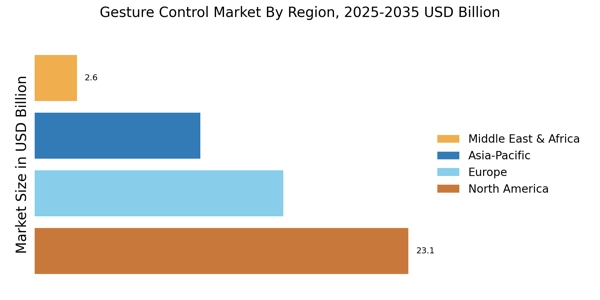Advancements in Sensor Technology
The Gesture Control Market is experiencing a notable surge due to advancements in sensor technology. Enhanced sensors, such as infrared and ultrasonic, are becoming increasingly sophisticated, allowing for more accurate gesture recognition. This technological evolution is pivotal, as it enables devices to interpret user movements with greater precision. According to recent data, the market for gesture recognition sensors is projected to grow at a compound annual growth rate of approximately 25% over the next five years. This growth is indicative of the rising demand for intuitive user interfaces across various sectors, including consumer electronics and healthcare. As these sensors become more affordable and accessible, their integration into everyday devices is likely to expand, further driving the Gesture Control Market.
Integration in Smart Home Devices
The integration of gesture control technology in smart home devices is a key driver for the Gesture Control Market. As smart homes become more prevalent, the demand for intuitive control mechanisms is rising. Gesture control allows users to interact with their devices seamlessly, enhancing convenience and user satisfaction. Recent statistics indicate that the smart home market is expected to reach a valuation of over 150 billion dollars by 2026, with gesture control playing a crucial role in this growth. The ability to control lighting, security systems, and entertainment devices through simple gestures is appealing to consumers, thereby fostering the expansion of the Gesture Control Market. This trend suggests a future where gesture-based interactions become standard in home automation.
Growing Demand for Touchless Technology
The Gesture Control Market is significantly influenced by the growing demand for touchless technology. As consumers increasingly seek hygienic solutions, especially in public spaces, gesture control systems offer an appealing alternative to traditional touch interfaces. This trend is particularly evident in sectors such as retail and hospitality, where minimizing physical contact is becoming a priority. Market analysis suggests that the touchless technology segment is expected to witness a substantial increase, with projections indicating a market size of over 10 billion dollars by 2026. This shift towards touchless solutions not only enhances user experience but also aligns with broader health and safety trends, thereby propelling the Gesture Control Market forward.
Rising Interest in Automotive Applications
The Gesture Control Market is increasingly influenced by the rising interest in automotive applications. As vehicles become more technologically advanced, the integration of gesture control systems is seen as a means to enhance driver safety and convenience. Gesture recognition allows drivers to control navigation, audio, and communication systems without taking their hands off the wheel. Recent projections suggest that the automotive gesture control market could reach a valuation of over 5 billion dollars by 2027. This growth is indicative of the automotive industry's commitment to innovation and user-centric design. As manufacturers continue to explore gesture-based interfaces, the Gesture Control Market is likely to benefit from this trend, paving the way for a new era of vehicle interaction.
Increased Adoption in Gaming and Entertainment
The Gesture Control Market is witnessing increased adoption in the gaming and entertainment sectors. As immersive experiences become more sought after, gesture control technology offers a unique way to engage users. This trend is particularly prominent in virtual reality (VR) and augmented reality (AR) applications, where gesture recognition enhances interactivity. Market data indicates that the gaming industry is projected to surpass 200 billion dollars by 2025, with gesture control systems likely to capture a significant share of this market. The ability to control games and experiences through natural movements not only enriches gameplay but also attracts a broader audience, thereby driving the Gesture Control Market forward. This evolution in user interaction is expected to redefine entertainment experiences in the coming years.


















Leave a Comment